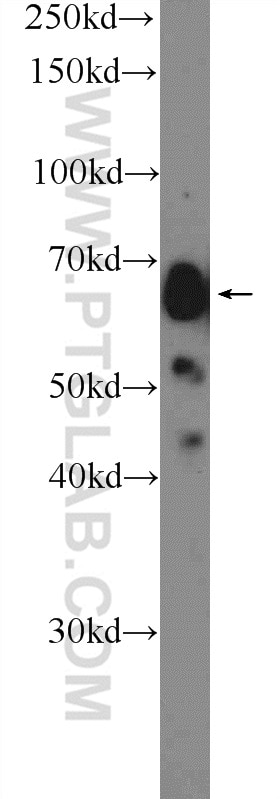Validation Data Gallery
Tested Applications
| Positive WB detected in | HepG2 cells, HEK-293 cells, HEK-293 cell line |
Recommended dilution
| Application | Dilution |
|---|---|
| Western Blot (WB) | WB : 1:500-1:1000 |
| It is recommended that this reagent should be titrated in each testing system to obtain optimal results. | |
| Sample-dependent, Check data in validation data gallery. | |
Published Applications
| WB | See 6 publications below |
| IF | See 3 publications below |
| IP | See 1 publications below |
Product Information
25175-1-AP targets Glypican 3 in WB, IF, IP, ELISA applications and shows reactivity with human samples.
| Tested Reactivity | human |
| Cited Reactivity | human, mouse |
| Host / Isotype | Rabbit / IgG |
| Class | Polyclonal |
| Type | Antibody |
| Immunogen |
CatNo: Ag10129 Product name: Recombinant human GPC3 protein Source: e coli.-derived, PET28a Tag: 6*His Domain: 232-580 aa of BC035972 Sequence: ALNLGIEVINTTDHLKFSKDCGRMLTRMWYCSYCQGLMMVKPCGGYCNVVMQGCMAGVVEIDKYWREYILSLEELVNGMYRIYDMENVLLGLFSTIHDSIQYVQKNAGKLTTTIGKLCAHSQQRQYRFAYYPEDLFIDKKVLKVAHVEHEETLSSRRRELIQKLKSFISFYSALPGYICSHSPVAENDTLCWNGQELVERYSQKAARNGMKNQFNLHELKMKGPEPVVSQIIDKLKHINQLLRTMSMPKGRVLDKNLDEEGFESGDCGDDEDECIGGSGDGMIKVKNQLRFLAELAYDLDVDDAPGNSQQATPKDNEISTFHNLGNVHSPLKLLTSMAISVVCFFFLVH 相同性解析による交差性が予測される生物種 |
| Full Name | glypican 3 |
| Calculated molecular weight | 580 aa, 66 kDa |
| Observed molecular weight | 66 kDa |
| GenBank accession number | BC035972 |
| Gene Symbol | GPC3 |
| Gene ID (NCBI) | 2719 |
| RRID | AB_2879942 |
| Conjugate | Unconjugated |
| Form | |
| Form | Liquid |
| Purification Method | Antigen affinity purification |
| UNIPROT ID | P51654 |
| Storage Buffer | PBS with 0.02% sodium azide and 50% glycerol{{ptg:BufferTemp}}7.3 |
| Storage Conditions | Store at -20°C. Stable for one year after shipment. Aliquoting is unnecessary for -20oC storage. |
Background Information
Glypicans (GPCs) are a family of glycosylphosphatidylinositol (GPI)-anchored heparan sulphate proteoglycans (HSPGs) that may play a role in the control of cell division and growth regulation. In mammals, there are six GPCs (GPC1 to GPC6), all of which have a similar core-protein size of approx. 60 kDa and the clustering of glycosaminoglycan attachment site near the C-terminus. They are tethered to the cell surface by GPI linkages, which can be cleaved by endogenous phospholipases, thus releasing the protein. Glypican 3 (GPC3) is highly expressed in many tissues during development and plays an important role in the regulation of embryonic growth (PMID: 22467855). Loss-of-function mutations of GPC3 result in the Simpson-Golabi-Behmel overgrowth syndrome (SGBS), and Gpc-3 null mice display developmental overgrowth (PMID: 8589713; 18477453). In hepatocellular carcinoma (HCC), the overexpression of glypican 3 has been demonstrated to be a reliable diagnostic indicator (PMID: 19212669; 22706665). The calculated molecular weight of native glypican 3 is 66 kDa, glycanated forms of glypican 3 have higher molecular weights than 66 kDa (PMID: 12851874; 16024626; 19574424).
Protocols
| Product Specific Protocols | |
|---|---|
| WB protocol for Glypican 3 antibody 25175-1-AP | Download protocol |
| Standard Protocols | |
|---|---|
| Click here to view our Standard Protocols |
Publications
| Species | Application | Title |
|---|---|---|
Hepatology The Mutational Features of Aristolochic Acid-Induced Mouse and Human Liver Cancers. | ||
Acta Pharm Sin B GPC3-mediated lysosome-targeting chimeras (GLTACs) for targeted degradation of membrane proteins | ||
Acta Biomater Enhanced glypican-3-targeted identification of hepatocellular carcinoma with liver fibrosis by pre-degrading excess fibrotic collagen | ||
Cancer Res hPCL3s promotes hepatocellular carcinoma metastasis by activating β-catenin signaling. | ||
Redox Biol Butaselen prevents hepatocarcinogenesis and progression through inhibiting thioredoxin reductase activity. | ||
Cancers (Basel) Therapeutic Adenovirus Vaccine Combined Immunization with IL-12 Induces Potent CD8+ T Cell Anti-Tumor Immunity in Hepatocellular Carcinoma |


